Unit8 Windy weather 第2课时 语法知识及拓展(课件)(共25张PPT)
文档属性
| 名称 | Unit8 Windy weather 第2课时 语法知识及拓展(课件)(共25张PPT) |  | |
| 格式 | pptx | ||
| 文件大小 | 329.8KB | ||
| 资源类型 | 试卷 | ||
| 版本资源 | 牛津上海版(试用本) | ||
| 科目 | 英语 | ||
| 更新时间 | 2022-05-20 22:42:24 | ||
图片预览

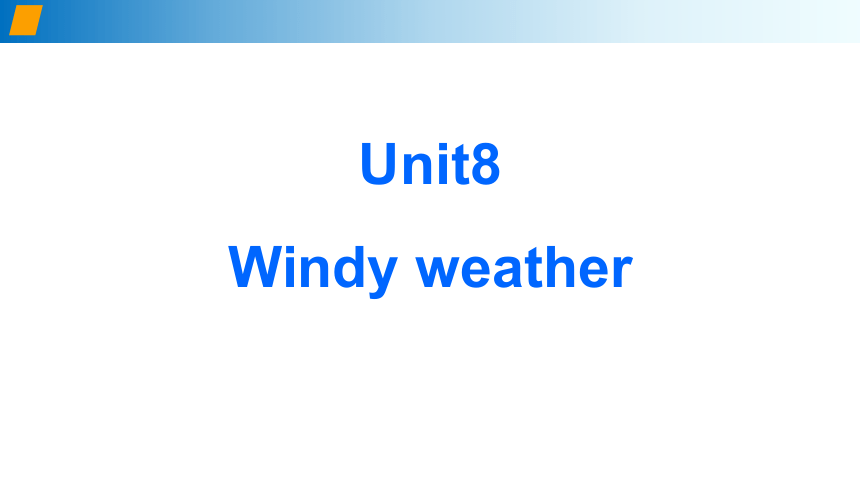
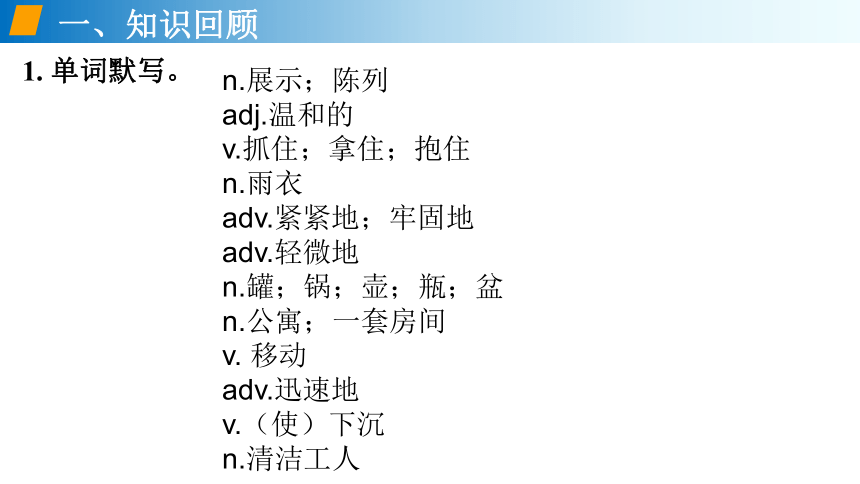
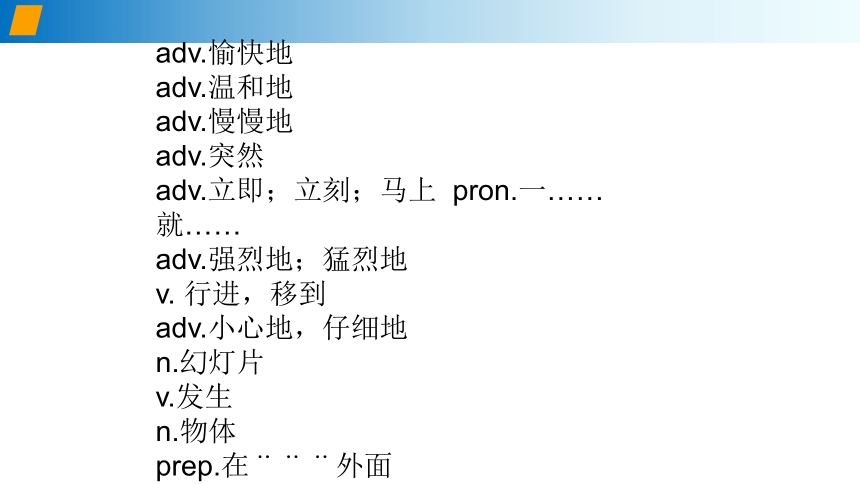
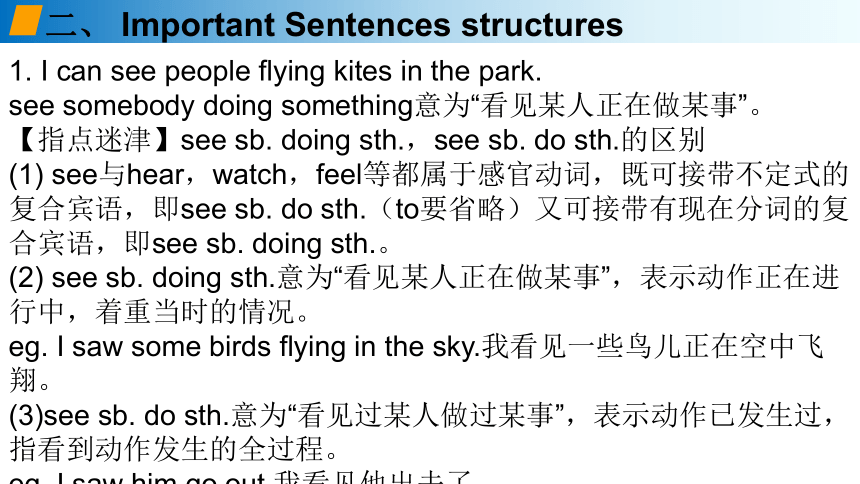
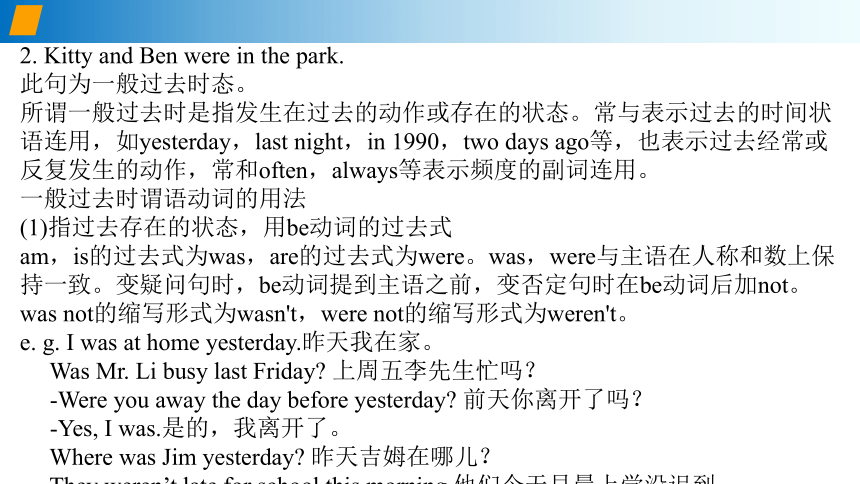
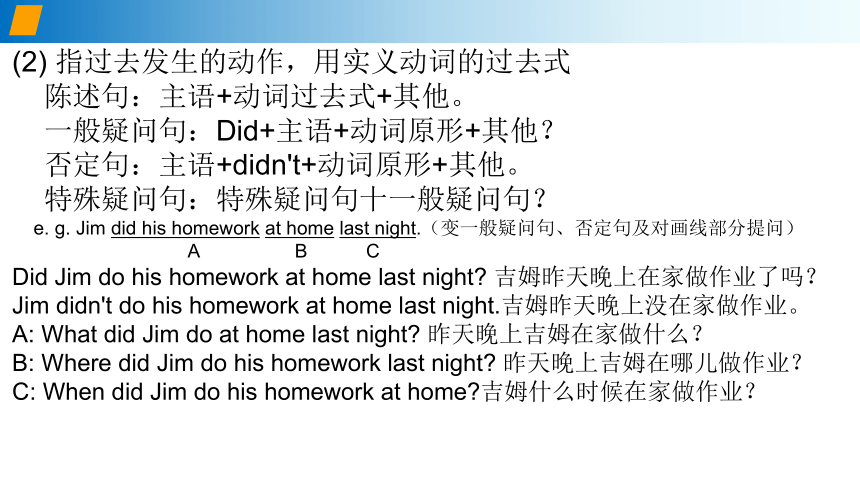
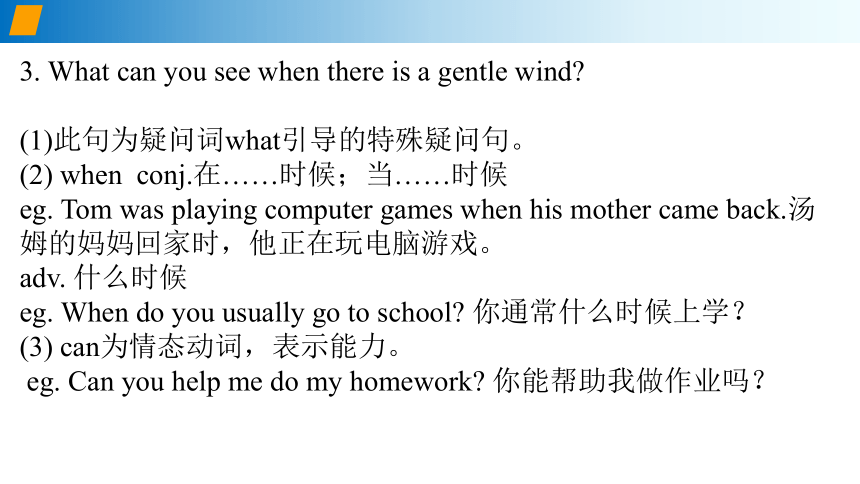

文档简介
(共25张PPT)
Lead in— 学海拾贝
沪教版 英语 六年级 第二学期
A friend in need is a friend indeed.
患难见真情。
Unit8
Windy weather
一、知识回顾
1. 单词默写。
n.展示;陈列
adj.温和的
v.抓住;拿住;抱住
n.雨衣
adv.紧紧地;牢固地
adv.轻微地
n.罐;锅;壶;瓶;盆
n.公寓;一套房间
v. 移动
adv.迅速地
v.(使)下沉
n.清洁工人
adv.愉快地
adv.温和地
adv.慢慢地
adv.突然
adv.立即;立刻;马上 pron.一……就……
adv.强烈地;猛烈地
v. 行进,移到
adv.小心地,仔细地
n.幻灯片
v.发生
n.物体
prep.在¨¨¨外面
二、 Important Sentences structures
1. I can see people flying kites in the park.
see somebody doing something意为“看见某人正在做某事”。
【指点迷津】see sb. doing sth.,see sb. do sth.的区别
(1) see与hear,watch,feel等都属于感官动词,既可接带不定式的复合宾语,即see sb. do sth.(to要省略)又可接带有现在分词的复合宾语,即see sb. doing sth.。
(2) see sb. doing sth.意为“看见某人正在做某事”,表示动作正在进行中,着重当时的情况。
eg. I saw some birds flying in the sky.我看见一些鸟儿正在空中飞翔。
(3)see sb. do sth.意为“看见过某人做过某事”,表示动作已发生过,指看到动作发生的全过程。
eg. I saw him go out.我看见他出去了。
2. Kitty and Ben were in the park.
此句为一般过去时态。
所谓一般过去时是指发生在过去的动作或存在的状态。常与表示过去的时间状语连用,如yesterday,last night,in 1990,two days ago等,也表示过去经常或反复发生的动作,常和often,always等表示频度的副词连用。
一般过去时谓语动词的用法
(1)指过去存在的状态,用be动词的过去式
am,is的过去式为was,are的过去式为were。was,were与主语在人称和数上保持一致。变疑问句时,be动词提到主语之前,变否定句时在be动词后加not。was not的缩写形式为wasn't,were not的缩写形式为weren't。
e. g. I was at home yesterday.昨天我在家。
Was Mr. Li busy last Friday 上周五李先生忙吗?
-Were you away the day before yesterday 前天你离开了吗?
-Yes, I was.是的,我离开了。
Where was Jim yesterday 昨天吉姆在哪儿?
They weren’t late for school this morning.他们今天早晨上学没迟到。
(2) 指过去发生的动作,用实义动词的过去式
陈述句:主语+动词过去式+其他。
一般疑问句:Did+主语+动词原形+其他?
否定句:主语+didn't+动词原形+其他。
特殊疑问句:特殊疑问句十一般疑问句?
e. g. Jim did his homework at home last night.(变一般疑问句、否定句及对画线部分提问)
A B C
Did Jim do his homework at home last night 吉姆昨天晚上在家做作业了吗?
Jim didn't do his homework at home last night.吉姆昨天晚上没在家做作业。
A: What did Jim do at home last night 昨天晚上吉姆在家做什么?
B: Where did Jim do his homework last night 昨天晚上吉姆在哪儿做作业?
C: When did Jim do his homework at home 吉姆什么时候在家做作业?
3. What can you see when there is a gentle wind
(1)此句为疑问词what引导的特殊疑问句。
(2) when conj.在……时候;当……时候
eg. Tom was playing computer games when his mother came back.汤姆的妈妈回家时,他正在玩电脑游戏。
adv. 什么时候
eg. When do you usually go to school 你通常什么时候上学?
(3) can为情态动词,表示能力。
eg. Can you help me do my homework 你能帮助我做作业吗?
4. They flew their kite happily.
副词在句子中的位置
副词修饰动词,通常放在句末。
e. g. The clouds moved quickly.云飘得很快。
副词放在句首,则修饰整个句子。
e. g. Suddenly, the telephone rang.突然电话响了。
三、语法讲解
一)副词的构成及其用法
1. 概念
副词(adverb,简写为adv)是一种用来修饰动词、形容词的词,说明时间、地点、程度、方式等概念的词。副词可分为:地点副词、方式副词、程度副词、疑问副词、连接副词。
2. 构成
1) 一般情况下直接加“ly”,如quick---quickly
2) 以“y”结尾的,先将“y”改成“i”,再加“ly”,如happy---happily
3) 绝大多数以e结尾的形容词仍然直接加-ly。如:polite-politely, wide-widely等。
4) 某些以辅音字母加不发音的字母e结尾和以-ue结尾的形容词要先去掉e,然后再加-y或-ly。如: terrible-terribly; true-truly; gentle-gently
5) 在形容词词尾直接加-ly。如:real-really; helpful-helpfully; careful-carefully; slow-slowly; quick-quickly; quiet-quietly
3. 用法
1)可以修饰动词,通常放于句末。
eg. The clouds moved quickly.
2)放于句首,修饰整个句子。
eg. Suddenly, the telephone rang.
二)情态动词may和should的用法
1. may可能
A. 表请求、许可
(1) 表示请求允许(即请求别人允许自己做某事)
eg. May I sit here 我可以坐在这里吗
(2) 表示给予允许(即自己允许别人做某事),通常要用 may
eg. You may come in now.你现在可以进来了。
You may not tell him this.你不可以告诉他这件事。
B. 表示推测 “可能是”
eg. He may know the answer.
注:在很正式的文体中,may可用于否定疑问句的句首。
C. 表示希望、祈求、祝愿,常可以译为“祝愿”
eg. May you have a good time. May you be happy.
2. should 用法
1)should表示义务或责,意为“应该”:
eg. We should learn from each other. 我们应该互相帮助。
We should help the aged. 我们应该帮助老人。
2)should 表示建议或劝告,意为“应该”
eg. You should give up smoking. 你应该戒烟。
You should go and ask your teacher. 你应该去问问老师。
3)should 表示推断,意为“应该”、“可能”
eg. The concert should be great fun. 音乐会应该很有意思。
注:should表示推断时,语气较肯定,通常是指非常可能的事(因为暗示有一定的事实依据或合乎常理),而may, might, could等表示推测时,则语气较不肯定,尤其是might, could。
eg.—When can I come for the photos I need them tomorrow afternoon.
—They _____ be ready by 12:00.
4)should 用于征求意见
主要用于第一人称的疑问句形式:
eg. Should I open the window 我可以打开窗户吗?
What should we do now 我们现在该干什么呢?
5)should表示意外或惊讶
与why, who, how 等疑问词连用:
eg. Why should you think that way 你为什么会那样想?
How should I know 我怎么会知道?
Rewrite the following sentences as required(改写句子,每空格限填一词):
1.She put a lot of money in the bank last year. (否定句)
She __________ __________ much money in the bank last year.
2.Maggie has already written some books about India.(改为一般疑问句)
__________ Maggie __________ any books about India yet
3.I’d like a flat with big windows. (对划线部分提问)
What _______ _______ flat would you like
4.We will move to the new flat on Nov. 20th .(对划线部分提问)
_______ _______ you move to the new flat
5.I want to live near the underground station.(保持句意基本不变)
I _______ want to live _______ away from the underground station.
【当堂检测】
1. didn’t put
2. Has written
3. kind of
4. When will
5. don’t far
【解析】
1.句意:去年她把很多钱存入了银行。
这个题目要求改为否定句,原句中使用的是一般过去时态,put是实意动词的过去式,否定句应用助动词did构成,与not缩写为didn’t,后面跟动词原形put。
2.句意:Maggie已经写了关于印度的一些书。
这个题目要求改为一般疑问句,原句使用的是现在完成时态,变一般疑问句时,直接将has提到主语的前面,故应填Has…written。
3.句意:我想要一个带大窗户的公寓。
原句中划线的部分是一个介词短语,修饰flat,因此我们应提问“你想要一个什么样的公寓”,用What kind of…提问,故这里填kind of。
4.句意:我们将在11月20日搬到新的公寓里去。
句中划线的部分表示的是一个时间,故疑问词用When,“什么时候”;原句使用的是一般将来时态,在疑问句中,应将will提到主语前面,故第二个空填will。
5.句意:我想住在地铁站附近。
句中away from意为“离…远”,结合原句的意思可知,这里应表示“我不想住得离地铁站远”,故第一个空填don’t,将原句变为了否定句;第二个空填far,与空后组成far away from,是一个固定短语。
6.She sings________. She wants to________ the music club.
A.well; join B.good; join C.good; join in D.well; join in
7.My father ________ the violin and he plays it _______.
A.can plays; good B.can’t play; good
C.can play; well D.doesn’t play; well
8.The test was so difficult. __________, I passed it.
A.Luck B.Lucky C.Luckly D.Luckily
9.My brother is a ________ English teacher. He can speak English ______.
A.well; good B.well; well C.good; well D.good; good
10.He is ________ young ________ go to school.
A.so; that B.too; to C.so; to D.too; that
6.A
【详解】
句意:她歌唱得好。她想加入音乐俱乐部。
考查副词用法和动词辨析。well好,副词;good好,形容词;join参加,其后通常是团体;join in参加,其后是一项活动。根据“sings”可知,副词修饰动词,well符合句意;根据“ the music club”可知,是一个俱乐部,join符合句意,故选A。
7.C
【详解】
句意:我父亲会拉小提琴,而且他拉得很好。
考查情态动词以及副词。空二处修饰动词“play”应用副词well“好”,排除AB;根据“he plays it...”可知他会拉小提琴,用情态动词can“可以”。故选C。
8.D
【详解】
句意:这场考试太难了。幸运地是,我通过了。
考查副词用法。luck幸运,名词;lucky幸运的,形容词;luckly形式错误;luckily幸运地,副词。根据逗号以及“I passed it.”可知,应用副词luckily修饰整个句子。故选D。
9.C
【详解】
句意:我哥哥是一名优秀的英语老师。他说英语说得好。
考查形容词和副词。well“好地”,是副词;good“好的”,是形容词。第一空修饰名词短语English teacher,用形容词;第二空修饰动词短语speak English,用副词,故选C。
10.B
【详解】
句意:他太小,不能上学。
考查非谓语动词。so...that引导结果状语从句;too...to...太……不能……,表否定。“go to school”动词短语,排除A和D;根据“young”和“go to school”可知此处指“太小,不能上学”,含否定意义,排除C;故选B。
11.Lisa can speak Chinese ________.
A.good B.soon C.nice D.well
12.—When could Jim swim
—________.
A.Three years before. B.Before three years. C.Three years ago D.Ago three years.
13.Bob does homework ________ to get an “A”.
A.too carefully B.carefully enough
C.so carefully D.enough carefully
14.Lucy is a _______ girl and she eats ________.
A.health; well B.healthy; good C.healthy; well D.health; good
15.Paul ________ goes swimming in rivers alone. He knows it’s dangerous.
A.never B.sometimes C.usually D.always
11.D【详解】
句意:丽莎的中文说得很好。
考查副词的用法。good好的,形容词;soon很快;nice好的,形容词;well好,副词。此处修饰动词“speak”用副词,且表示“说得好”,用well。故选D。
12.C【详解】
句意:——吉姆什么时候能游泳?——3年前。
考查时间状语。根据could可知,此处表达过去的能力,应该用过去的时间,所以空处应是一般过去时的标志性时间,there years是确切的时间,常与ago连用;befoe用过过去时态,不与确切时间连用。故选C。
13.B【详解】
句意:鲍勃做作业足够认真,能够得到一个A。
考查enough的用法。too carefully to...太认真而不能;enough“足够”,修饰形容词或副词时,放在形容词或副词之后,carefully enough足够认真,排除D,形容词/副词+enough to do sth.意为“足够……能做某事”;so carefully如此认真。结合后文to get an “A”,故选B。
14.C【详解】
句意:露西是一个健康的女孩,她吃得很好。
考查形容词和副词辨析。health健康,名词;well好,副词;healthy健康的,形容词;good好的,形容词。第一个空修饰名词girl用形容词healthy;第二个空修饰动词eats用副词well。 故选C。
15.A【详解】
句意:保罗从不独自去河里游泳。他知道这很危险。
考查频度副词。never从不;sometimes有时;usually通常;always总是。根据“He knows it’s dangerous.”可知,他从不独自去河里游泳。故选A。
16.The coat ________ be Peter’s, but I am not sure.
A.can’t B.needn’t C.may D.must
17.—Johnny, is the soccer ball in the classroom yours
—No, it isn’t. It ________ be Jackie’s but I’m not sure.
A.may B.must C.can’t D.needn’t
18.—How long __________ I keep this book
—Only one week. You __________ return it before next Friday.
A.must; must B.may; may C.must; may D.may; must
19.—What is your father going to do this Sunday
—I’m not sure. He ________ go to see my grandmother.
A.can B.must C.may D.should
20.Cars, buses and bikes ________ stop when the traffic lights change to red.
A.can B.may C.must D.need
16.C【详解】
句意:这件外套可能是Peter的,但我不确定。
考查情态动词。can’t不可能;needn’t不需要;may可能;must一定,根据“but I am not sure”可知,应该是这件外套可能是Peter的,故选C。
17.A【详解】
句意:——Johnny,教室里的足球是你的吗?——不,它不是。它可能是Jackie的,但是我不确定。
考查情态动词辨析。may可能;must一定;can’t不可能;needn’t不必。根据“but I’m not sure.”可知,可能是他的,不太确定,故选A。
18.D【详解】
句意:——这本书我可以借多长时间?——只有一周。你必须在下周五之前归还。
考查情态动词的用法。must必须;may可以。第一句是表示“请求许可”,用may;第二空根据“You...return it before next Friday.”结合语境可知是指必须在指定的时间前归还书,用must。故选D。
19.C【详解】
句意:——你爸爸这个星期天打算做什么?——我不知道。他可能去看我的祖母。
考查动词辨析。can可以;must必须;may也许;should应该。根据“I’m not sure.”可知,此处表示不确定的推测,应用may,故选C。
20.C【详解】
句意:当交通信号灯变红的时候,小汽车、公交车以及自行车都必须停下来。
考查情态动词词义辨析。can能,会;may 可能;must必须;need需要。一旦交通信号灯变红,所有车都必须停下来。故选must。故选C。
21.We ________ be more careful, or we will make the same mistake in the experiment.
A.might B.can C.may D.should
22.We ________ be more careful, or we will lose the chance again.
A.can B.might C.may D.should
23.The sign “No Smoking” in the subway means passengers ________ smoke.
A.can B.should C.mustn’t D.needn’t
24.— This robot is great.
— Wow, it has video cameras in its eyes, so it ________ “see” and interact(交流)with people.
A.may B.can C.must D.should
25.—Chris, you ________ swim alone. It’s dangerous.
—Oh, I won’t do that again.
A.should B.shouldn’t C.had better D.must
21.D
【详解】
句意:我们应该更认真,否则我们会在实验中犯同样的错误。
考查情态动词词义辨析。might可以;can能够,可以;may可以;should应该。根据“or we will make the same mistake in the experiment.”可知,我们应该更加细心一点。空处表示“应该”的含义。故选D。
22.D
【详解】
句意:我们应该更加小心,否则我们会再次失去机会。
考查情态动词。can能,会;might可能;may可以;should应该。根据“or we will lose the chance again.”可知,此处是应该更小心。故选D。
23.C
【详解】
句意:地铁里的“禁止吸烟”标志意味着乘客不能吸烟。
考查情态动词。can可以;should应该;mustn’t 禁止;needn’t没有必要。根据“No Smoking”可知,意为“禁止吸烟”,结合选项,“mustn’t”符合句意。故选C。
24.B【详解】
句意:—— 这个机器人很棒。—— 哇,它的眼睛里有摄像头,所以它可以“看到”人并与人互动。
考查情态动词。may可以,表示许可;can能够,表示能力;must一定,必须;should应该。根据“it has video cameras in its eyes”可知,眼睛里有摄像机,所以具备“看”的能力。故选B。
25.B【详解】
句意:——克里斯,你不应该一个人游泳。这是危险的。——我不会再那么做了。
考查情态动词。should应该;shouldn’t不应该;had better最好;must必须。根据“Chris, you...swim alone. It’s dangerous.”可知,因为危险,所以不应该一个人游泳。故选B。
愿君皆有所获,皆有所得
Lead in— 学海拾贝
沪教版 英语 六年级 第二学期
A friend in need is a friend indeed.
患难见真情。
Unit8
Windy weather
一、知识回顾
1. 单词默写。
n.展示;陈列
adj.温和的
v.抓住;拿住;抱住
n.雨衣
adv.紧紧地;牢固地
adv.轻微地
n.罐;锅;壶;瓶;盆
n.公寓;一套房间
v. 移动
adv.迅速地
v.(使)下沉
n.清洁工人
adv.愉快地
adv.温和地
adv.慢慢地
adv.突然
adv.立即;立刻;马上 pron.一……就……
adv.强烈地;猛烈地
v. 行进,移到
adv.小心地,仔细地
n.幻灯片
v.发生
n.物体
prep.在¨¨¨外面
二、 Important Sentences structures
1. I can see people flying kites in the park.
see somebody doing something意为“看见某人正在做某事”。
【指点迷津】see sb. doing sth.,see sb. do sth.的区别
(1) see与hear,watch,feel等都属于感官动词,既可接带不定式的复合宾语,即see sb. do sth.(to要省略)又可接带有现在分词的复合宾语,即see sb. doing sth.。
(2) see sb. doing sth.意为“看见某人正在做某事”,表示动作正在进行中,着重当时的情况。
eg. I saw some birds flying in the sky.我看见一些鸟儿正在空中飞翔。
(3)see sb. do sth.意为“看见过某人做过某事”,表示动作已发生过,指看到动作发生的全过程。
eg. I saw him go out.我看见他出去了。
2. Kitty and Ben were in the park.
此句为一般过去时态。
所谓一般过去时是指发生在过去的动作或存在的状态。常与表示过去的时间状语连用,如yesterday,last night,in 1990,two days ago等,也表示过去经常或反复发生的动作,常和often,always等表示频度的副词连用。
一般过去时谓语动词的用法
(1)指过去存在的状态,用be动词的过去式
am,is的过去式为was,are的过去式为were。was,were与主语在人称和数上保持一致。变疑问句时,be动词提到主语之前,变否定句时在be动词后加not。was not的缩写形式为wasn't,were not的缩写形式为weren't。
e. g. I was at home yesterday.昨天我在家。
Was Mr. Li busy last Friday 上周五李先生忙吗?
-Were you away the day before yesterday 前天你离开了吗?
-Yes, I was.是的,我离开了。
Where was Jim yesterday 昨天吉姆在哪儿?
They weren’t late for school this morning.他们今天早晨上学没迟到。
(2) 指过去发生的动作,用实义动词的过去式
陈述句:主语+动词过去式+其他。
一般疑问句:Did+主语+动词原形+其他?
否定句:主语+didn't+动词原形+其他。
特殊疑问句:特殊疑问句十一般疑问句?
e. g. Jim did his homework at home last night.(变一般疑问句、否定句及对画线部分提问)
A B C
Did Jim do his homework at home last night 吉姆昨天晚上在家做作业了吗?
Jim didn't do his homework at home last night.吉姆昨天晚上没在家做作业。
A: What did Jim do at home last night 昨天晚上吉姆在家做什么?
B: Where did Jim do his homework last night 昨天晚上吉姆在哪儿做作业?
C: When did Jim do his homework at home 吉姆什么时候在家做作业?
3. What can you see when there is a gentle wind
(1)此句为疑问词what引导的特殊疑问句。
(2) when conj.在……时候;当……时候
eg. Tom was playing computer games when his mother came back.汤姆的妈妈回家时,他正在玩电脑游戏。
adv. 什么时候
eg. When do you usually go to school 你通常什么时候上学?
(3) can为情态动词,表示能力。
eg. Can you help me do my homework 你能帮助我做作业吗?
4. They flew their kite happily.
副词在句子中的位置
副词修饰动词,通常放在句末。
e. g. The clouds moved quickly.云飘得很快。
副词放在句首,则修饰整个句子。
e. g. Suddenly, the telephone rang.突然电话响了。
三、语法讲解
一)副词的构成及其用法
1. 概念
副词(adverb,简写为adv)是一种用来修饰动词、形容词的词,说明时间、地点、程度、方式等概念的词。副词可分为:地点副词、方式副词、程度副词、疑问副词、连接副词。
2. 构成
1) 一般情况下直接加“ly”,如quick---quickly
2) 以“y”结尾的,先将“y”改成“i”,再加“ly”,如happy---happily
3) 绝大多数以e结尾的形容词仍然直接加-ly。如:polite-politely, wide-widely等。
4) 某些以辅音字母加不发音的字母e结尾和以-ue结尾的形容词要先去掉e,然后再加-y或-ly。如: terrible-terribly; true-truly; gentle-gently
5) 在形容词词尾直接加-ly。如:real-really; helpful-helpfully; careful-carefully; slow-slowly; quick-quickly; quiet-quietly
3. 用法
1)可以修饰动词,通常放于句末。
eg. The clouds moved quickly.
2)放于句首,修饰整个句子。
eg. Suddenly, the telephone rang.
二)情态动词may和should的用法
1. may可能
A. 表请求、许可
(1) 表示请求允许(即请求别人允许自己做某事)
eg. May I sit here 我可以坐在这里吗
(2) 表示给予允许(即自己允许别人做某事),通常要用 may
eg. You may come in now.你现在可以进来了。
You may not tell him this.你不可以告诉他这件事。
B. 表示推测 “可能是”
eg. He may know the answer.
注:在很正式的文体中,may可用于否定疑问句的句首。
C. 表示希望、祈求、祝愿,常可以译为“祝愿”
eg. May you have a good time. May you be happy.
2. should 用法
1)should表示义务或责,意为“应该”:
eg. We should learn from each other. 我们应该互相帮助。
We should help the aged. 我们应该帮助老人。
2)should 表示建议或劝告,意为“应该”
eg. You should give up smoking. 你应该戒烟。
You should go and ask your teacher. 你应该去问问老师。
3)should 表示推断,意为“应该”、“可能”
eg. The concert should be great fun. 音乐会应该很有意思。
注:should表示推断时,语气较肯定,通常是指非常可能的事(因为暗示有一定的事实依据或合乎常理),而may, might, could等表示推测时,则语气较不肯定,尤其是might, could。
eg.—When can I come for the photos I need them tomorrow afternoon.
—They _____ be ready by 12:00.
4)should 用于征求意见
主要用于第一人称的疑问句形式:
eg. Should I open the window 我可以打开窗户吗?
What should we do now 我们现在该干什么呢?
5)should表示意外或惊讶
与why, who, how 等疑问词连用:
eg. Why should you think that way 你为什么会那样想?
How should I know 我怎么会知道?
Rewrite the following sentences as required(改写句子,每空格限填一词):
1.She put a lot of money in the bank last year. (否定句)
She __________ __________ much money in the bank last year.
2.Maggie has already written some books about India.(改为一般疑问句)
__________ Maggie __________ any books about India yet
3.I’d like a flat with big windows. (对划线部分提问)
What _______ _______ flat would you like
4.We will move to the new flat on Nov. 20th .(对划线部分提问)
_______ _______ you move to the new flat
5.I want to live near the underground station.(保持句意基本不变)
I _______ want to live _______ away from the underground station.
【当堂检测】
1. didn’t put
2. Has written
3. kind of
4. When will
5. don’t far
【解析】
1.句意:去年她把很多钱存入了银行。
这个题目要求改为否定句,原句中使用的是一般过去时态,put是实意动词的过去式,否定句应用助动词did构成,与not缩写为didn’t,后面跟动词原形put。
2.句意:Maggie已经写了关于印度的一些书。
这个题目要求改为一般疑问句,原句使用的是现在完成时态,变一般疑问句时,直接将has提到主语的前面,故应填Has…written。
3.句意:我想要一个带大窗户的公寓。
原句中划线的部分是一个介词短语,修饰flat,因此我们应提问“你想要一个什么样的公寓”,用What kind of…提问,故这里填kind of。
4.句意:我们将在11月20日搬到新的公寓里去。
句中划线的部分表示的是一个时间,故疑问词用When,“什么时候”;原句使用的是一般将来时态,在疑问句中,应将will提到主语前面,故第二个空填will。
5.句意:我想住在地铁站附近。
句中away from意为“离…远”,结合原句的意思可知,这里应表示“我不想住得离地铁站远”,故第一个空填don’t,将原句变为了否定句;第二个空填far,与空后组成far away from,是一个固定短语。
6.She sings________. She wants to________ the music club.
A.well; join B.good; join C.good; join in D.well; join in
7.My father ________ the violin and he plays it _______.
A.can plays; good B.can’t play; good
C.can play; well D.doesn’t play; well
8.The test was so difficult. __________, I passed it.
A.Luck B.Lucky C.Luckly D.Luckily
9.My brother is a ________ English teacher. He can speak English ______.
A.well; good B.well; well C.good; well D.good; good
10.He is ________ young ________ go to school.
A.so; that B.too; to C.so; to D.too; that
6.A
【详解】
句意:她歌唱得好。她想加入音乐俱乐部。
考查副词用法和动词辨析。well好,副词;good好,形容词;join参加,其后通常是团体;join in参加,其后是一项活动。根据“sings”可知,副词修饰动词,well符合句意;根据“ the music club”可知,是一个俱乐部,join符合句意,故选A。
7.C
【详解】
句意:我父亲会拉小提琴,而且他拉得很好。
考查情态动词以及副词。空二处修饰动词“play”应用副词well“好”,排除AB;根据“he plays it...”可知他会拉小提琴,用情态动词can“可以”。故选C。
8.D
【详解】
句意:这场考试太难了。幸运地是,我通过了。
考查副词用法。luck幸运,名词;lucky幸运的,形容词;luckly形式错误;luckily幸运地,副词。根据逗号以及“I passed it.”可知,应用副词luckily修饰整个句子。故选D。
9.C
【详解】
句意:我哥哥是一名优秀的英语老师。他说英语说得好。
考查形容词和副词。well“好地”,是副词;good“好的”,是形容词。第一空修饰名词短语English teacher,用形容词;第二空修饰动词短语speak English,用副词,故选C。
10.B
【详解】
句意:他太小,不能上学。
考查非谓语动词。so...that引导结果状语从句;too...to...太……不能……,表否定。“go to school”动词短语,排除A和D;根据“young”和“go to school”可知此处指“太小,不能上学”,含否定意义,排除C;故选B。
11.Lisa can speak Chinese ________.
A.good B.soon C.nice D.well
12.—When could Jim swim
—________.
A.Three years before. B.Before three years. C.Three years ago D.Ago three years.
13.Bob does homework ________ to get an “A”.
A.too carefully B.carefully enough
C.so carefully D.enough carefully
14.Lucy is a _______ girl and she eats ________.
A.health; well B.healthy; good C.healthy; well D.health; good
15.Paul ________ goes swimming in rivers alone. He knows it’s dangerous.
A.never B.sometimes C.usually D.always
11.D【详解】
句意:丽莎的中文说得很好。
考查副词的用法。good好的,形容词;soon很快;nice好的,形容词;well好,副词。此处修饰动词“speak”用副词,且表示“说得好”,用well。故选D。
12.C【详解】
句意:——吉姆什么时候能游泳?——3年前。
考查时间状语。根据could可知,此处表达过去的能力,应该用过去的时间,所以空处应是一般过去时的标志性时间,there years是确切的时间,常与ago连用;befoe用过过去时态,不与确切时间连用。故选C。
13.B【详解】
句意:鲍勃做作业足够认真,能够得到一个A。
考查enough的用法。too carefully to...太认真而不能;enough“足够”,修饰形容词或副词时,放在形容词或副词之后,carefully enough足够认真,排除D,形容词/副词+enough to do sth.意为“足够……能做某事”;so carefully如此认真。结合后文to get an “A”,故选B。
14.C【详解】
句意:露西是一个健康的女孩,她吃得很好。
考查形容词和副词辨析。health健康,名词;well好,副词;healthy健康的,形容词;good好的,形容词。第一个空修饰名词girl用形容词healthy;第二个空修饰动词eats用副词well。 故选C。
15.A【详解】
句意:保罗从不独自去河里游泳。他知道这很危险。
考查频度副词。never从不;sometimes有时;usually通常;always总是。根据“He knows it’s dangerous.”可知,他从不独自去河里游泳。故选A。
16.The coat ________ be Peter’s, but I am not sure.
A.can’t B.needn’t C.may D.must
17.—Johnny, is the soccer ball in the classroom yours
—No, it isn’t. It ________ be Jackie’s but I’m not sure.
A.may B.must C.can’t D.needn’t
18.—How long __________ I keep this book
—Only one week. You __________ return it before next Friday.
A.must; must B.may; may C.must; may D.may; must
19.—What is your father going to do this Sunday
—I’m not sure. He ________ go to see my grandmother.
A.can B.must C.may D.should
20.Cars, buses and bikes ________ stop when the traffic lights change to red.
A.can B.may C.must D.need
16.C【详解】
句意:这件外套可能是Peter的,但我不确定。
考查情态动词。can’t不可能;needn’t不需要;may可能;must一定,根据“but I am not sure”可知,应该是这件外套可能是Peter的,故选C。
17.A【详解】
句意:——Johnny,教室里的足球是你的吗?——不,它不是。它可能是Jackie的,但是我不确定。
考查情态动词辨析。may可能;must一定;can’t不可能;needn’t不必。根据“but I’m not sure.”可知,可能是他的,不太确定,故选A。
18.D【详解】
句意:——这本书我可以借多长时间?——只有一周。你必须在下周五之前归还。
考查情态动词的用法。must必须;may可以。第一句是表示“请求许可”,用may;第二空根据“You...return it before next Friday.”结合语境可知是指必须在指定的时间前归还书,用must。故选D。
19.C【详解】
句意:——你爸爸这个星期天打算做什么?——我不知道。他可能去看我的祖母。
考查动词辨析。can可以;must必须;may也许;should应该。根据“I’m not sure.”可知,此处表示不确定的推测,应用may,故选C。
20.C【详解】
句意:当交通信号灯变红的时候,小汽车、公交车以及自行车都必须停下来。
考查情态动词词义辨析。can能,会;may 可能;must必须;need需要。一旦交通信号灯变红,所有车都必须停下来。故选must。故选C。
21.We ________ be more careful, or we will make the same mistake in the experiment.
A.might B.can C.may D.should
22.We ________ be more careful, or we will lose the chance again.
A.can B.might C.may D.should
23.The sign “No Smoking” in the subway means passengers ________ smoke.
A.can B.should C.mustn’t D.needn’t
24.— This robot is great.
— Wow, it has video cameras in its eyes, so it ________ “see” and interact(交流)with people.
A.may B.can C.must D.should
25.—Chris, you ________ swim alone. It’s dangerous.
—Oh, I won’t do that again.
A.should B.shouldn’t C.had better D.must
21.D
【详解】
句意:我们应该更认真,否则我们会在实验中犯同样的错误。
考查情态动词词义辨析。might可以;can能够,可以;may可以;should应该。根据“or we will make the same mistake in the experiment.”可知,我们应该更加细心一点。空处表示“应该”的含义。故选D。
22.D
【详解】
句意:我们应该更加小心,否则我们会再次失去机会。
考查情态动词。can能,会;might可能;may可以;should应该。根据“or we will lose the chance again.”可知,此处是应该更小心。故选D。
23.C
【详解】
句意:地铁里的“禁止吸烟”标志意味着乘客不能吸烟。
考查情态动词。can可以;should应该;mustn’t 禁止;needn’t没有必要。根据“No Smoking”可知,意为“禁止吸烟”,结合选项,“mustn’t”符合句意。故选C。
24.B【详解】
句意:—— 这个机器人很棒。—— 哇,它的眼睛里有摄像头,所以它可以“看到”人并与人互动。
考查情态动词。may可以,表示许可;can能够,表示能力;must一定,必须;should应该。根据“it has video cameras in its eyes”可知,眼睛里有摄像机,所以具备“看”的能力。故选B。
25.B【详解】
句意:——克里斯,你不应该一个人游泳。这是危险的。——我不会再那么做了。
考查情态动词。should应该;shouldn’t不应该;had better最好;must必须。根据“Chris, you...swim alone. It’s dangerous.”可知,因为危险,所以不应该一个人游泳。故选B。
愿君皆有所获,皆有所得
同课章节目录
- Module 1 City life
- Unit 1 Great cities in Asia
- Unit 2 At the airport
- Unit 3 Dragon Boat Festival
- Unit 4 Staying healthy
- Module 2 Changes
- Unit 5 What will I be like?
- Unit 6 Seasonal changes
- Unit 7 Travelling in Garden City
- Module 3 The nature world
- Unit 8 Windy weathe
- Unit 9 Sea water and rain wate
- Unit 10 Forests and land
- Unit 11 Controlling fire
